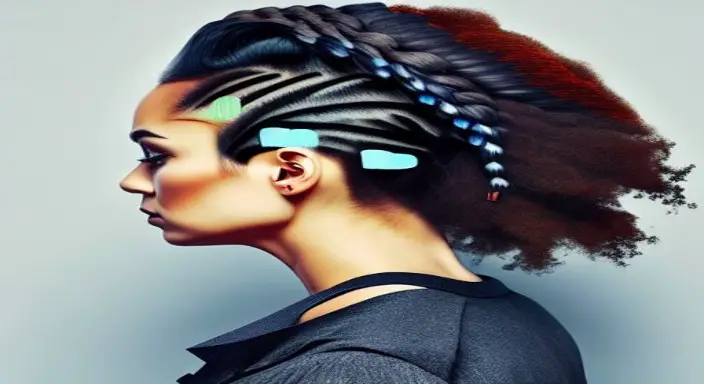The painting does relaxing and enjoyable, but it can quickly become a nightmare when you accidentally get oil-based paint on your hair. This is harder to remove than water-based paint, so you need a different process. The thought of cutting your hair to remove the paint might have crossed your mind, but there’s no need to do that yet! Let’s share tips on how to remove oil based paint from hair:
- Identify the type of paint.
- Gather the appropriate materials
- Prepare the hair
- Remove the paint
- Rinse the hair
- Re-wash the hair
- Dry the hair
- Treat the hair
- Style the hair
- Take preventative measures
Firstly, knowing the oil-based paint, you’re dealing with is essential, as different types have different removal processes.
Secondly, avoid using hot water or heat-styling tools that could make the paint deeper into your hair strands.
Our blog post will guide you through removing oil-based paint from your hair using household items like baby oil or peanut butter.
At the end of this post, you’ll finally understand the stress-free way of getting.
How To Remove Oil-Based Paint from Hair
1. Identify the type of paint
If you’ve accidentally gotten paint in your hair, don’t panic. With the right tools and determination, you can remove the paint without damaging your hair.
The first step is to identify the type of paint in your hair. Unlike acrylic or water-based paint, oil-based paint will require a specific removal process.

To determine whether you have oil-based paint in your hair, look at the instructions or label on the paint container.
It is likely oil-based if it contains solvents like mineral spirits, turpentine, or paint thinner.
Once you have determined that the paint is oil-based, you can move on to the next step in the removal process.
2. Gather the appropriate materials
Removing oil-based paint from hair can be daunting, but with the appropriate materials, you can effectively clean your hair without damaging it.
First, you must gather the necessary products: a comb or brush, baby oil or olive oil, dish soap, and a towel.
The comb or brush should be sturdy enough to work through your hair, as oil-based paint can make it matted and tangled.

Baby oil or olive oil will help to break down the paint and make it easier to remove without damaging your hair.
Dish soap will remove the oil, paint, and any remaining residue. A towel will come in handy to wipe any excess materials or to dry your hair once you have finished.
With these materials, you can easily remove oil-based paint from your hair.
3. Prepare the hair
Removing oil-based paint from your hair can be a daunting experience. Fortunately, you can take a few easy steps to prepare your hair before attempting to remove the paint.
Before doing anything else, wearing gloves is important to prevent the paint from spreading even further.

Then, use a generous amount of petroleum jelly or baby oil to coat the affected areas of your hair.
It will help loosen the paint and provide a protective barrier for your hair and scalp. After applying the petroleum jelly or baby oil, use a comb to carefully separate the strands of hair, ensuring that the oil penetrates through the hair to reach the oil-based paint.
Take your time and repeat the process until the affected areas are fully coated.
Once you have followed these steps, you will be better prepared to remove the oil-based paint from your hair.
4. Remove the paint
Remove oil-based paint from hair; acting quickly and with the correct tools is important. One effective method is removing the paint using a solvent, such as mineral spirits or rubbing alcohol. However, it is important to note that these solvents can harm the scalp and should be used cautiously.

It is also important to avoid using harsh chemicals such as acetone or bleach on the hair, as these can cause further damage.
Instead, removing the paint by gently washing the hair with warm, soapy water is a safer method.
If the paint persists, gently apply a generous amount of vegetable oil to the affected area and use a fine-tooth comb to work the paint out of the hair.
Finally, wash the hair with a gentle shampoo to remove any remaining residue.
Following these steps makes it possible to safely and effectively remove oil-based paint from hair.
5. Rinse the hair
If you’ve ever been tasked with painting a room or handling some DIY household project, you probably know how easy it is to accidentally get paint in your hair.
Oil-based paint can be difficult to remove from hair, but it’s not impossible. One effective method is to rinse the hair to remove the paint. Start by running warm water over your hair and saturate the areas with paint.

Next, apply a generous amount of shampoo to your hair and work it into a lather. Rinse your hair thoroughly with warm water, removing all traces of the paint.
Repeat the shampoo and rinse cycle as necessary until the paint is completely gone.
Using hot water can make it harder to remove the paint, so stick with warm water to avoid worsening the situation.
6. Re-wash the hair
When working on a painting or home improvement project, it’s not uncommon to accidentally get oil-based paint onto your hair.
While it may seem daunting, there are several effective ways to remove oil-based paint from hair without damaging your locks. One effective method is to re-wash the hair with grease-fighting dish soap or shampoo.

Apply the soap to the affected hair and work it into a lather. Rinse the soap and repeat until the paint has been completely removed.
Remember that this method may strip the hair of natural oils, so follow up with a moisturizing conditioner.
This method is particularly effective for removing fresh paint, so it’s best to act before it dries and sticks to the hair.
Remember to use lukewarm water when washing, as hot water can cause the oil-based paint to set even more. With these simple steps, you can remove oil-based paint from your hair and return to your project with clean, paint-free locks.
7. Dry the hair
Removing oil-based paint from hair can be challenging, but it can do with the right technique. If you’ve got oil-based paint in your hair, you must act quickly to minimize the damage.
A hairdryer is one of the most effective methods to remove oil-based paint from hair. First, locate a hair dryer and set it on a high heat setting. Please turn it on and begin to direct it to your hair.

The hair dryer’s heat will help soften the oil-based paint, making removing it much easier.
You can then use a comb or brush to remove the loosened paint from your hair. Repeat this process until all the paint has been removed.
Being patient and gentle when using this method is essential, as too much force or heat can damage your hair.
8. Treat the hair
Oil-based paint is common in many painting projects but can lead to undesirable consequences when contacting hair.
Removing oil-based paint can be a challenge, and doing so without causing any damage to your hair requires the use of specific techniques.
One useful method is to treat the hair with a mixture of dish soap and warm water. This mixture helps to break down and remove the oil-based paint from the hair without damaging it.

Saturate your hair with the mixture, massage it into the affected area, and then rinse thoroughly to remove the paint.
It is essential to avoid rubbing the hair vigorously as this could lead to tangling and damage.
Using this technique, you can effectively remove oil-based paint from your hair while maintaining healthy locks.
9. Style the hair
Oil-based paint stains on hair can be a frustrating experience, but they can remove with the right methods. One effective solution is to style your hair with a hairdryer and comb the paint out as you style.

Before beginning:
- Make sure the hair is completely dry. Using a hair dryer in a cool setting, dry the hair in the opposite direction of the paint stain. It will help the paint loosen from the hair strands.
- Use a fine-tooth comb to comb the paint out of the hair gently.
- Be careful not to pull on the hair or damage the strands.
- Style the hair and comb the paint out until it is fully removed. This method may take some time and patience, but it removes oil-based paint from hair.
10. Take preventative measures
If you work with oil-based paints or are an avid DIY enthusiast, you know how difficult it can be to remove paint from your hair.
Prevention is key when removing oil-based paint from hair, as once it has dried into your hair, it can be a challenge to get out.

By taking these preventative steps, you’ll be able to avoid messy situations and keep your hair looking fresh and clean.
Expert Opinion
Oil-based paint can be a real headache when it gets into your hair, but it can remove with patience and the right technique.
Remember to act quickly and avoid using water, as this can cause the paint to liquefy and spread throughout your hair.
Instead, use a solvent like mineral spirits or baby oil, and work it gently into your hair to break down the paint.
With persistence and careful washing, you can restore your hair to its former glory and avoid future painting mishaps.
On the other hand, using simple and safe techniques like dish soap, baby oil, and vinegar, you can easily eliminate the paint from your hair without damaging it.
It’s essential to act fast when paint gets on your hair and to avoid using harsh chemicals that can cause skin irritation and hair damage.
With the right approach and patience, you can get your hair back to normal and enjoy a pain-free life.




